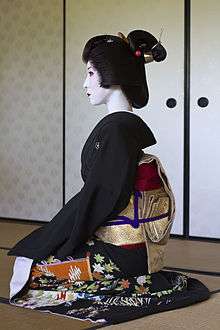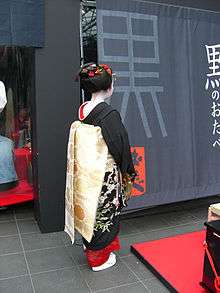Geisha

Geisha (芸者) (/ˈɡeɪʃə/; Japanese: [ɡeːɕa]),[1][2] geiko (芸子), or geigi (芸妓) are Japanese women who entertain through performing the ancient traditions of art, dance and singing, and are distinctively characterized by traditional costumes and makeup. Contrary to popular belief, geishas are not the Eastern equivalent of the prostitute; a misconception originating in the West due to interactions with oiran, whose traditional dress is similar to that of geisha.
Terms
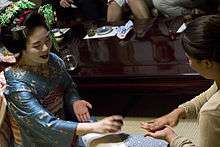
The word geisha consists of two kanji, 芸 (Gei) meaning "art" and 者 (Sha) meaning "person" or "doer". The most literal translation of geisha into English would be "artist", "performing artist", or "artisan". Another name for geisha is Geiko (芸妓), which translates specifically as "Woman of Art". This term is used to refer to geisha from Western Japan, which includes Kyoto and Kanazawa.
Apprentice geisha are called Maiko (舞妓), literally "Woman of Dance", or Hangyoku (半玉), "Half-Jewel" (meaning that they were paid half of the wage of a full geisha),[3] or by the more generic term o-shaku (御酌), literally "one who pours (alcohol)". The white make-up and elaborate kimono and hair of a maiko is the popular image held of geisha. A woman entering the geisha community does not have to begin as a maiko, having the opportunity to begin her career as a full geisha. Either way, however, usually a year's training is involved before debuting either as a maiko or as a geisha. A woman above 21 is considered too old to be a maiko and becomes a full geisha upon her initiation into the geisha community.
On average, Tokyo apprentices (who typically begin at 18) are slightly older than their Kyoto counterparts (who usually start at 15).[4] Historically, geisha often began the earliest stages of their training at a very young age, sometimes as early as 6 years old. The early Shikomi (in-training) and Minarai (learns by watching) stages of geisha training lasted for years (shikomi) and months (minarai) respectively, which is significantly longer than in contemporary times. A girl is often a shikomi for up to a year while the modern minarai period is simply one month.
It is still said that geisha inhabit a separate world which they call the Karyūkai or "The Flower and Willow World". Before they disappeared, the courtesans were the colourful "flowers" and the geisha the "willows" because of their subtlety, strength, and grace.[5]
History
Origins
In the early stages of Japanese history, there were female entertainers: Saburuko (serving girls) were mostly wandering girls whose families were displaced from struggles in the late 600s. Some of these saburuko girls sold sexual services, while others with a better education made a living by entertaining at high-class social gatherings. After the imperial court moved the capital to Heian-kyō (Kyoto) in 794 the conditions that would form geisha culture began to emerge, as it became the home of a beauty-obsessed elite.[6] Skilled female performers, such as Shirabyōshi dancers, thrived.
Traditional Japan embraced sexual delights (it is not a Shinto taboo) and men were not constrained to be faithful to their wives.[7] The ideal wife was a modest mother and manager of the home; by Confucian custom love had secondary importance. For sexual enjoyment and romantic attachment, men did not go to their wives, but to courtesans. Walled-in pleasure quarters known as yūkaku (遊廓、遊郭) were built in the 16th century,[8] and in 1617 the shogunate designated "pleasure quarters", outside of which prostitution would be illegal,[9] and within which yūjo ("play women") would be classified and licensed. The highest yūjo class was the geisha's predecessor, called tayuu, a combination of actress and prostitute, originally playing on stages set in the dry Kamo riverbed in Kyoto. They performed erotic dances and skits, and this new art was dubbed kabuku, meaning "to be wild and outrageous". The dances were called "kabuki", and this was the beginning of kabuki theater.[9]
18th-century emergence of the geisha
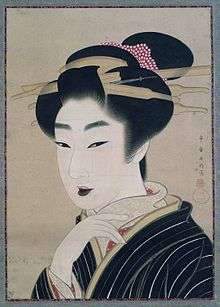
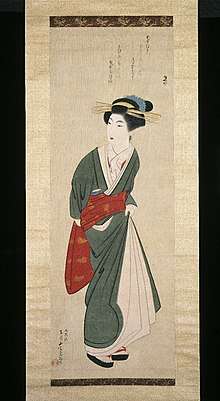
These pleasure quarters quickly became glamorous entertainment centers, offering more than sex. The highly accomplished courtesans of these districts entertained their clients by dancing, singing, and playing music. Some were renowned poets and calligraphers. Gradually, they all became specialized and the new profession, purely of entertainment, arose. It was near the turn of the eighteenth century that the first entertainers of the pleasure quarters, called geisha, appeared. The first geishas were men, entertaining customers waiting to see the most popular and gifted courtesans (oiran).[9]
The forerunners of the female geisha were the teenage odoriko ("dancing girls"):[10] expensively trained as chaste dancers-for-hire. In the 1680s, they were popular paid entertainers in the private homes of upper-class samurai,[11] though many had turned to prostitution by the early 18th century. Those who were no longer teenagers (and could no longer style themselves odoriko[12]) adopted other names—one being "geisha", after the male entertainers. The first woman known to have called herself geisha was a Fukagawa prostitute, in about 1750.[13] She was a skilled singer and shamisen player named Kikuya who was an immediate success, making female geisha extremely popular in 1750s Fukagawa.[14] As they became more widespread throughout the 1760s and 1770s, many began working only as entertainers (rather than prostitutes), often in the same establishments as male geisha.[15]
Rise of the geisha

The geisha who worked within the pleasure quarters were essentially imprisoned and strictly forbidden to sell sex in order to protect the business of the oiran. While licensed courtesans existed to meet men's sexual needs, machi geisha carved out a separate niche as artists and erudite female companions.
By 1800, being a geisha was considered a female occupation (though there are still a handful of male geisha working today). Eventually, the gaudy Oiran began to fall out of fashion, becoming less popular than the chic ("iki") and modern geisha.[9] By the 1830s, the evolving geisha style was emulated by fashionable women throughout society.[16] There were many different classifications and ranks of geisha. Some women would have sex with their male customers, whereas others would entertain strictly with their art forms.[17] Prostitution in Japan was legal up until 1908, so it was practiced throughout Japan.
World War II brought a huge decline in the geisha arts because most women had to go to factories or elsewhere to contribute to post war reconstruction. The geisha name also lost some status during this time because prostitutes began referring to themselves as "geisha girls" to American military men.[18] In 1944, the geisha world, including the teahouses, bars and geisha houses, was forced to close, and all employees were put to work in factories. About a year later, they were allowed to reopen. The few women who returned to the geisha areas decided to reject Western influence and revert to traditional ways of entertainment and life. "The image of the geisha was formed during Japan's feudal past, and this is now the image they must keep in order to remain geisha."[18] It was up to these returning geisha to bring back traditional standards in the profession, though with increased rights for the geisha:
After Japan lost the war, geisha dispersed and the profession was in shambles. When they regrouped during the Occupation and began to flourish in the 1960s during Japan's postwar economic boom, the geisha world changed. In modern Japan, girls are not sold into indentured service. Nowadays, a geisha's sex life is her private affair.
There were many rumors that stated before the war, a maiko's virginity would be auctioned (the original "mizuage").[20][21] But this was confused with the girls who were apprentices to prostitutes and courtesans.[22] Compulsory education laws passed in the 1960s made traditional geisha apprenticeships difficult, leading to a decline in women entering the field.[23]
In her book Geisha, a Life, Mineko Iwasaki said: "I lived in the karyukai during the 1960s and 1970s, a time when Japan was undergoing the radical transformation from a post-feudal to a modern society. But I existed in a world apart, a special realm whose mission and identity depended on preserving the time-honored traditions of the past."[24]
Ranking
At the pinnacle of the complex geisha ranking system are the grand dowagers of Kyoto. The Gokagai of Kyoto are its five geisha districts,[25] also known as hanamachi ("flower towns"). Gion Kobu, Pontocho and Kamishichiken have the highest status;[26] they are very expensive and are frequented by powerful businessmen and politicians[9] (Gion Kobu is sometimes seen as having the very highest ranking). As reported by Dalby (1983) from her impressions in 1975[27] Geiko from the other two hanamachi (Gion Higashi and Miyagawa Cho) have high prestige but are considered to be one rank lower.
Stages of training
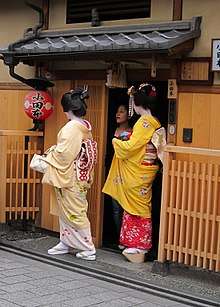
Traditionally, Geisha began their training at a young age. Some girls were bonded to geisha houses (okiya) as children. Daughters of geisha were often brought up as geisha themselves, usually as the successor (atotori, meaning "heir" or "heiress" in this particular situation) or daughter-role (musume-bun) to the okiya.
A maiko is an apprentice and is therefore bonded under a contract to her okiya. The okiya supplies her with food, board, kimono, obi, and other tools of her trade. Her training is very expensive and her debt must be repaid to the okiya with the earnings she makes. This repayment may continue after the maiko becomes a full-fledged geisha and only when her debts are settled is she permitted to move out to live and work independently.[6]
A maiko will start her formal training on the job as a minarai, which literally means "learning by watching" at an ozashiki (お座敷, a banquet in any traditional Japanese building with tatami), to sit and observe as the other maiko and geiko interact with customers. This is a way in which she will gain insights of the job, and seek out potential clients. Although minarai attend ozashiki, they do not participate at an advanced level. Their kimono, more elaborate than a geiko's, are intended to do the talking for them. Minarai can be hired for parties but are usually uninvited (yet welcomed) guests at parties that their onee-san attends. They only charge a third of the usual fee. Minarai generally work with a particular tea house (Minarai-jaya) learning from the okaa-san (literally "mother", the proprietress of the house). From her, they would learn techniques such as conversation and gaming, which would not be taught to them in school. This stage lasts only about a month or so.[28]
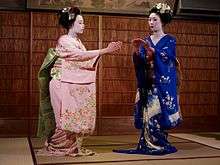
After a short period the final stage of training begins, and the students are now called "maiko", rather than minarai. Maiko (literally "dance girl") are apprentice geisha, and this stage can last for up to 5 years. Maiko learn from their senior maiko and geiko mentors. The onee-san and imouto-san (senior/junior, literally "older sister/younger sister") relationship is important. The onee-san, any maiko or geiko who is senior to a girl, teaches her maiko everything about working in the hanamachi. The onee-san will teach her proper ways of serving tea, playing shamisen, dancing, casual conversation and more.
There are three major elements of a maiko's training. The first is the formal arts training. This takes place in special geisha schools which are found in every hanamachi. The second element is the entertainment training which the maiko learns at various tea houses and parties by observing her onee-san. The third is the social skill of navigating the complex social web of the hanamachi. This is done on the streets. Formal greetings, gifts, and visits are key parts of any social structure in Japan and for a maiko, they are crucial for her to build the support network she needs to survive as a geisha.
Maiko are considered one of the great sights of Japanese tourism, and look very different from fully qualified geisha. They are at the peak of traditional Japanese femininity. The scarlet-fringed collar of a maiko's kimono hangs very loosely in the back to accentuate the nape of the neck, which is considered a primary erotic area in Japanese sexuality. She wears the same white makeup for her face on her nape, leaving two or sometimes three stripes of bare skin exposed. Her kimono is bright and colourful with an elaborately tied obi hanging down to her ankles. She takes very small steps and wears traditional wooden shoes called okobo which stand nearly ten centimeters high.[6] There are five different hairstyles that a maiko wears, that mark the different stages of her apprenticeship. The "Nihongami" hairstyle with "kanzashi" hair-ornamentation strips is most closely associated with maiko,[29] who spend hours each week at the hairdresser and sleep on holed-pillows to preserve the elaborate styling.[30] Maiko can develop a bald spot on their crown caused by rubbing from Kanzashi strips and tugging in hairdressing.
Around the age of 20–21, the maiko is promoted to a full-fledged geisha in a ceremony called erikae (turning of the collar).[20][31] This could happen after three to five years of her life as a maiko or hangyoku, depending on at what age she debuted. Geisha remain as such until they retire.
Female dominance in geisha society
The biggest industry in Japan is not shipbuilding, producing cultured pearls, or manufacturing transistor radios or cameras. It is entertainment.
— Boye De Mente, Some Prefer Geisha[32]
The term geisha literally translates to "entertainer". Some prostitutes refer to themselves as "geisha", but they are not. A geisha's sex and love life is usually distinct from her professional life. A successful geisha can entertain her male customers with music, dance, and conversation.
Geishas are not submissive and subservient, but in fact they are some of the most financially and emotionally successful and strongest women in Japan, and traditionally have been so.
— Iwasaki Mineko, Geisha, A Life[24]
Geisha learn the traditional skills of dance and instruments and hold high social status. Geisha are single women, though they may have lovers or boyfriends whom they have personally picked, who support them financially.
There is currently no western equivalent for a geisha—they are truly the most impeccable form of Japanese art.
— Kenneth Champeon, The Floating World[33]
Relationships with male guests
The appeal of a high-ranking geisha to her typical male guest has historically been very different from that of his wife. The ideal geisha showed her skill, while the ideal wife was modest. The ideal geisha seemed carefree, the ideal wife somber and responsible. Historically, geisha did sometimes marry their clients, but marriage necessitated retirement, as there were never married geisha.
Geisha may gracefully flirt with their guests, but they will always remain in control of the hospitality. Over their years of apprenticeship they learn to adapt to different situations and personalities, mastering the art of the hostess.[34]
Geisha as a women-centered society
Women in the geisha society are some of the most successful businesswomen in Japan. In the geisha society, women run everything. Without the impeccable business skills of the female tea house owners, the world of geisha would cease to exist. The tea house owners are entrepreneurs, whose service to the geisha is highly necessary for the society to run smoothly. Infrequently, men take contingent positions such as hair stylists,[35] dressers (dressing a maiko requires considerable strength) and accountants,[18] but men have a limited role in geisha society.
The geisha system was founded, actually, to promote the independence and economic self-sufficiency of women. And that was its stated purpose, and it actually accomplished that quite admirably in Japanese society, where there were very few routes for women to achieve that sort of independence.
The majority of women were wives who did not work outside of their familial duties. Becoming a geisha was a way for women to support themselves without becoming a wife. Thus, some argue that geisha women live in a women-centered society. Women run the geisha houses, they are teachers, they run the tea houses, they recruit aspiring geisha, and they keep track of a geisha's finances. The only major role men play in geisha society is that of guest, though women sometimes take that role as well.[35]
Historically, Japanese feminists have seen geisha as exploited women, but some modern geisha see themselves as liberated feminists:[37] "We find our own way, without doing family responsibilities. Isn't that what feminists are?"[18]
Modern geisha
Modern geisha still live in traditional geisha houses called okiya in areas called hanamachi (花街 "flower streets"), particularly during their apprenticeship. Many experienced geisha are successful enough to choose to live independently. The elegant, high-culture world that geisha are a part of is called karyūkai (花柳界 "the flower and willow world").
Before the twentieth century, geisha training began when a girl was around the age of six. Now, girls must go to school until they are 15 years old and have graduated from middle school and then make the personal decision to train to become a geisha. Young women who wish to become geisha now most often begin their training after high school or even college. Many more women begin their careers in adulthood.[38]
Geisha still study traditional instruments: the shamisen, shakuhachi, and drums, as well as learn games,[39] traditional songs, calligraphy,[40] Japanese traditional dances (in the nihonbuyō style), tea ceremony, literature, and poetry.[41][42]
By watching other geisha, and with the assistance of the owner of the geisha house, apprentices also become skilled dealing with clients and in the complex traditions surrounding selecting and wearing kimono, a floor length silk robe embroidered with intricate designs which is held together by a sash at the waist which is called an obi.[43][44]
In modern Japan, geisha and their apprentices are now a rare sight outside hanamachi or chayagai (茶屋街, literally "tea house district", often referred to as "entertainment district"). In the 1920s, there were over 80,000 geisha in Japan,[45][46] but today, there are far fewer. Most common are sightings of tourists who pay a fee to be dressed up as a maiko.[47]
A sluggish economy, declining interest in the traditional arts, the exclusive nature of the flower and willow world, and the expense of being entertained by geisha have all contributed to the tradition's decline.[48] However, the flower and willow world has seen a resurgence in new members over the last 10 years due to the accessibility that the internet has provided for young girls wanting to know more about the profession and not needing a formal introduction to an okiya.
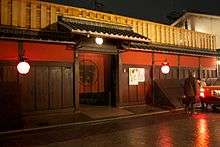
Geisha are often hired to attend parties and gatherings, traditionally at ochaya (お茶屋, literally "tea houses") or at traditional Japanese restaurants (ryōtei).[44] The charge for a geisha's time, which used to be determined by measuring a burning incense stick, is called senkōdai (線香代, "incense stick fee") or gyokudai (玉代 "jewel fee"). Now they are flat fees charged by the hour. In Kyoto, the terms ohana (お花) and hanadai (花代), meaning "flower fees", are preferred. The okasan makes arrangements through the geisha union office (検番 kenban), which keeps each geisha's schedule and makes her appointments both for entertaining and for training.
Non-Japanese geisha
Since the 1970s, non-Japanese have also attempted to become geishas. Liza Dalby, an American national worked briefly with geisha in the Pontocho district of Kyoto as part of her doctorate research, although she did not formally debut as a geisha herself. [49][50]
The district of Gion in Kyoto, Japan does not accept non-Japanese women to train for becoming a geisha due to their traditional environment.
Other foreign nationals who have completed training and worked as geisha in Japan include the following:
- Sayuki — Sayuki (Fiona Graham) was an Australian geisha who debuted in the Asakusa district of Tokyo in 2007.[51][52]
- Kimichō - an American-born geisha previously employed at the Yoshinoya okiya in Tokyo, Japan.[53]
- Rinka — (Zhang Xue) a Chinese national from Shenyang, China who became a geisha in Shimoda Japan.
- Ibu — (Eve) a geiko of Ukrainian descent working in Anjo district of Aichi Prefecture.[54]
- Juri — (Maria) a Peruvian geiko working in the resort town of Yugawara in Kanagawa Prefecture.
- Fukutarō — (Isabella) a Romanian national worked in the Izu-Nagaoka district of Shizuoka Prefecture.[55][56]
- Mutsuki — (Yi Xin Sun) a Chinese national worked in Shinagawa ward in Tokyo.
Public performances
While traditionally geishas have led a cloistered existence, in recent years they have become more publicly visible, and entertainment is available without requiring the traditional introduction and connections.
The most visible form of this are public dances, or odori (generally written in traditional kana spelling as をどり, rather than modern おどり), featuring both maikos and geishas. All the Kyoto hanamachi hold these annually (mostly in spring, with one exclusively in autumn), dating to the Kyoto exhibition of 1872,[57] and there are many performances, with tickets being inexpensive, ranging from around 1500 yen to 4500 yen – top-price tickets also include an optional tea ceremony (tea and wagashi served by maiko) before the performance;[58] see Kyoto hanamachi and Kanazawa hanamachi for a detailed listing. Other hanamachi also hold public dances, including some in Tokyo, but have fewer performances.[58]
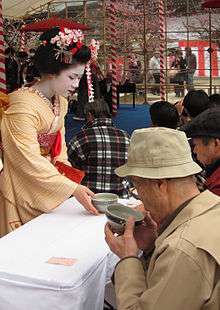
Another notable event is that the geishas (including maikos) of the Kamishichiken district in northwest Kyoto serve tea to 3,000 guests on February 25 in an annual open-air tea ceremony (野点, nodate) at the plum-blossom festival (梅花祭, baikasai) at Kitano Tenman-gū shrine.[59][60] As of 2010, these geishas also serve beer in a beer garden at Kamishichiken Kaburenjo Theatre during summer months (July to early September);[61][62][63] another geisha beer garden is available at the Gion Shinmonso ryokan in the Gion district.[61] These beer gardens also feature traditional dances by the geishas in the evenings.
Arts
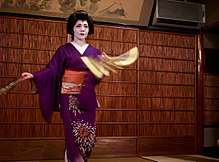
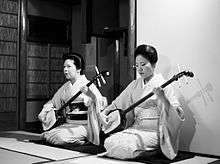
Geisha begin their study of music and dance when they are very young and continue it throughout their lives. Geisha can work into their eighties and nineties,[64] and are expected to train every day even after seventy years of experience.[65]
The dance of the geisha has evolved from the dance performed on the noh and kabuki stages. The "wild and outrageous" dances transformed into a more subtle, stylized, and controlled form of dance. It is extremely disciplined, similar to t'ai chi. Every dance uses gestures to tell a story and only a connoisseur can understand the subdued symbolism. For example, a tiny hand gesture represents reading a love letter, holding the corner of a handkerchief in the mouth represents coquetry and the long sleeves of the elaborate kimono are often used to symbolize dabbing tears.[9]
The dances are accompanied by traditional Japanese music. The primary instrument is the shamisen. The shamisen was introduced to the geisha culture in 1750 and has been mastered by female Japanese artists for years.[66] This shamisen, originating in Okinawa, is a banjo-like three-stringed instrument that is played with a plectrum. It has a very distinct, melancholy sound that is often accompanied by flute. The instrument is described as "melancholy" because traditional shamisen music uses only minor thirds and sixths.[66] All geisha must learn shamisen-playing, though it takes years to master. Along with the shamisen and the flute, geisha also learned to play a ko-tsuzumi, a small, hourglass-shaped shoulder drum, and a large floor taiko (drum). Some geisha would not only dance and play music, but would write beautiful, melancholy poems. Others painted pictures or composed music.[9]
Geisha and prostitution
Sheridan Prasso wrote that Americans had "an incorrect impression of the real geisha world ... geisha means 'arts person' trained in music and dance, not in the art of sexual pleasure".[67] K. G. Henshall wrote that the geisha's purpose was "to entertain their customer, be it by dancing, reciting verse, playing musical instruments, or engaging in light conversation. Geisha engagements may include flirting with men and playful innuendos; however, clients know that nothing more can be expected. In a social style that is common in Japan, men are amused by the illusion of that which is never to be."[68]
In 1872, shortly after the Meiji Restoration, the new government passed a law liberating "prostitutes (shōgi) and geisha (geigi)". The wording of this statute was the subject of controversy. Some officials thought that prostitutes and geisha worked at different ends of the same profession—selling sex— and that all prostitutes should henceforth be called "geisha". In the end, the government decided to maintain a line between the two groups, arguing that geisha were more refined and should not be soiled by association with prostitutes.[69]
Also, geisha working in onsen towns such as Atami are dubbed onsen geisha. Onsen geisha have been given a bad reputation due to the prevalence of prostitutes in such towns who market themselves as "geisha". In contrast to these "one-night geisha", the true onsen geisha are competent dancers and musicians. However, the autobiography of Sayo Masuda, an onsen geisha who worked in Nagano Prefecture in the 1930s, reveals that in the past, such women were often under intense pressure to sell sex.[3]
Personal relationships and Danna partnership
Geisha are portrayed as unattached. Formerly those who chose to marry had to retire from the profession, though today, some geisha are allowed to marry. It was traditional in the past for established geisha to take a danna, or patron. A danna was typically a wealthy man, sometimes married, who had the means to support the very large expenses related to a geisha's traditional training and other costs. This sometimes occurs today as well, but very rarely. A geisha and her danna may or may not be in love, but intimacy is never viewed as a reward for the danna's financial support. While it is true that a geisha is free to pursue personal relationships with men she meets through her work, such relationships are carefully chosen and unlikely to be casual. A hanamachi tends to be a very tight-knit community and a geisha's good reputation is not taken lightly.
"Geisha (Gee-sha) girls"
During the period of the Allied occupation of Japan, local women called "Geisha girls" worked as prostitutes. They almost exclusively serviced American GIs stationed in the country, who actually referred to them as "Geesha girls" (a mispronunciation).[70][71] These women dressed in kimono and imitated the look of geisha. Many Americans unfamiliar with the Japanese culture could not tell the difference between legitimate geisha and these costumed performers.[70] Shortly after their arrival in 1945, some occupying American GIs are said to have congregated in Ginza and shouted, "We want geesha girls!"[72]
Eventually, the English term "geisha girl" became a general word for any female Japanese prostitute or worker in the mizu shōbai and included bar hostesses and streetwalkers.[70]
Geisha girls are speculated by researchers to be largely responsible for the continuing misconception in the West that all geisha are engaged in prostitution.[70]
Mizuage
Mizuage (水揚げ) was a ceremony undergone by a maiko where she was promoted to senior status and changed her hairstyle from the junior wareshinobu to the senior ofuku.[70] A ritual deflowering, also called mizuage, was practiced among prostitutes and geisha in smaller towns where these occupations often blurred lines. Prostitutes posing as geisha often used this term to refer to their acts with customers, which lead to great confusion when such prostitutes often called themselves "geisha" in the company of foreign soldiers and even Japanese customers.[73]
Mizuage literally means "raising the waters" and originally meant unloading a ship's cargo of fish.[74] Over time, the word came to represent money earned in the entertainment business.[6]
Appearance
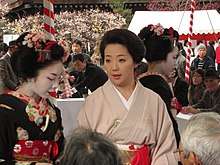
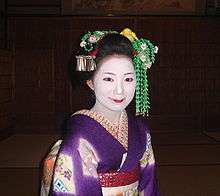
A geisha's appearance changes throughout her career, from the girlish, heavily made-up maiko, to the more somber appearance of an older established geisha. Different hairstyles and hairpins signify different stages of a girl's development and even a detail as minute as the length of one's eyebrows is significant. Short eyebrows are for the young and long eyebrows display maturity.[70]
Makeup
In modern times the traditional makeup of apprentice geisha is one of their most recognizable characteristics, though established geisha generally only wear full white face makeup characteristic of maiko during special performances.
The traditional makeup of an apprentice geisha features a thick white base with red lipstick and red and black accents around the eyes and eyebrows. Originally, the white base mask was made with lead; after the discovery that it poisoned the skin and caused terrible skin and back problems for the older geisha towards the end of the Meiji Era, it was replaced with rice powder.
The application of makeup is hard to perfect and is time-consuming. Makeup is applied before dressing to avoid dirtying the kimono. First, a wax or oil substance called bintsuke-abura is applied to the skin. Next, white powder is mixed with water into a paste and applied with a bamboo brush starting from the neck and working upwards. The white makeup covers the face, neck, and chest, with two or three unwhitened areas (forming a W or V shape, usually a traditional W shape) left on the nape, to accentuate this traditionally erotic area, and a line of bare skin around the hairline, which creates the illusion of a mask.
After the foundation layer is applied, a sponge is patted all over the face, throat, chest, the nape and neck to remove excess moisture and to blend the foundation. Next the eyes and eyebrows are drawn in. Traditionally, charcoal was used, but today, modern cosmetics are used. The eyebrows and edges of the eyes are coloured black with a thin charcoal; a maiko also applies red around her eyes.
The lips are filled in using a small brush. The colour comes in a small stick, which is melted in water. Crystallized sugar is then added to give the lips luster. Rarely will a geisha colour in both lips fully in the Western style, as white creates optical illusions and colouring the lips fully would make them appear overly large. The lower lip is coloured in partially and the upper lip left white for maiko in her first year, after which the upper lip is coloured. Newly full-fledged geisha will colour in only the top lip fully. Most geisha wear the top lip coloured in fully or stylized, and the bottom lip in a curved stripe that does not follow the shape of the lip. Geisha round the bottom lips to create the illusion of a flower bud.
Maiko who are in their last stage of training sometimes colour their teeth black for a brief period. This practice used to be common among married women in Japan and, earlier, at the imperial court, but survives only in some districts. It is done partly because uncoloured teeth seem very yellow in contrast to white face makeup; colouring the teeth black means that they seem to "disappear" in the darkness of the open mouth. This illusion is of course more pronounced at a distance.
For the first year, a maiko wears this heavy makeup almost constantly. During her initiation, the maiko is helped with her makeup either by her onee-san, or "older sister" (an experienced geisha who is her mentor), or by the okaa-san, or "mother" of her geisha house. After this, she applies the makeup herself.
After a maiko has been working for three years, she changes her make-up to a more subdued style. The reason for this is that she has now become mature, and the simpler style shows her own natural beauty. For formal occasions, the mature geisha will still apply white make-up. For geisha over thirty, the heavy white make-up is only worn during those special dances that require it.
Dress
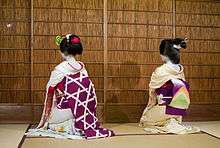
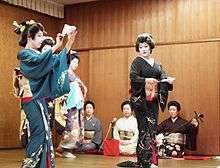
Geisha always wear kimono. Apprentice geisha wear highly colourful kimono with extravagant obi. The obi is brighter than the kimono she is wearing to give a certain exotic balance. Maiko of Kyoto wear the obi tied in a style called "darari" (dangling obi), while Tokyo "hangyoku" wear it tied in various ways, including taiko musubi. Older geisha of Kyoto wear more subdued patterns and styles (most notably the obi tied in a simpler knot used by married women known as the "taiko musubi" (太鼓結び), or "drum knot"). Tokyo and Kanazawa geisha wear "yanagi musubi" (柳結び, willow style), taiko musubi and "tsunodashi musubi" (角出結び).
The colour, pattern, and style of kimono is dependent on the season and the event the geisha is attending. A kimono can take from two to three years to complete, due to painting and embroidering.
Geiko wear red or pink nagajuban, or under-kimono. A maiko wears red with white printed patterns. The junior maiko's collar is predominantly red with white, silver, or gold embroidery. Two to three years into her apprenticeship, the red collar will be entirely embroidered in white (when viewed from the front) to show her seniority. When she becomes a fully fledged geisha her collar will turn from red to solid white.
Geisha wear raised wooden sandals, called geta while maiko wear a special wooden sandal known as okobo and wear only tabi (white split-toed socks) indoors. Geisha and apprentices wear the flat-soled sandal zōri outdoors during inclement weather.
Hair
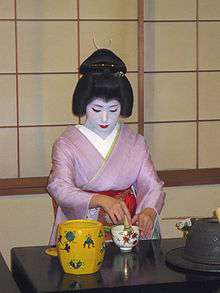
The hairstyles of geisha have varied through history. In the past, it has been common for women to wear their hair down in some periods and up in others. During the 17th century, women began putting all their hair up again, and it is during this time that the traditional shimada hairstyle, a type of chignon worn by most established geisha, developed.
There are two major types of the shimada seen in the karyukai: the Taka Shimada, a high mage (high section) usually worn by young, single women and the Tsubushi Shimada, a more flattened mage generally worn by older women Additional hairstyles for maiko include Wareshinobu, Ofuku, Katsuyama, Yakko Shimada, and Sakkō. Maiko of Pontocho will wear an additional six hairstyles leading up to Sakkō, including Oshidori, Kikugasane, Yuiwata, Suisha, Oshun, and Osafune.
These hairstyles are decorated with elaborate hair-combs and hairpins (kanzashi). Beginning In the seventeenth century and continuing through the Meiji Restoration period, hair-combs were large and conspicuous, generally more ornate for higher-class women. Following the Meiji Restoration and into the modern era, smaller and less conspicuous hair-combs became more popular.
Maiko sleep with their necks on small supports (takamakura), instead of pillows, so they keep their hairstyle perfect.[35] Even if there are no accidents, a maiko will need her hair styled every week. Many modern geisha use wigs in their professional lives, while maiko use their natural hair.[75] Either must be regularly tended by highly skilled artisans. Traditional hairstyling is a slowly dying art. Over time, the hairstyle can cause balding on the top of the head.
Sakkō (先笄) is a Japanese hairstyle. It is worn by maiko today, but was worn in the Edo period by wives to show their dedication to their husbands. Maiko wear it during a ceremony called Erikae, which marks their graduation from maiko to geiko. Maiko use black wax to stain their teeth as well. Crane and tortoiseshell ornaments are added as kanzashi. The style is twisted in many knots, and is quite striking and elaborate.
In popular culture
A growing number of geisha have complained to the authorities about being pursued down the street and tugged on the sleeves of their kimonos by groups of tourists keen to take their photograph. As a result, residents and local businesses have joined forces to protect the geisha by launching patrols of the streets of Kyoto's Gion entertainment district in order to prevent tourists from pestering them.[76]
Many stories are told about geisha. This includes Arthur Golden's popular English-language novel Memoirs of a Geisha which was adapted into a film in 2005.
Films about geisha
- Sisters of the Gion (1936)—Dir. Kenji Mizoguchi
- The Life of Oharu (西鶴一代女 Saikaku Ichidai Onna) (1952)—Dir. Kenji Mizoguchi
- A Geisha (祇園囃子, Gion bayashi) (1953)—Dir. Kenji Mizoguchi
- The Teahouse of the August Moon (1956)—Dir. Daniel Mann
- The Barbarian and the Geisha (1958)—Dir. John Huston
- The Geisha Boy (1958)—Dir. Frank Tashlin
- Late Chrysanthemums (Bangiku) (1958)—Dir. Mikio Naruse
- Cry for Happy (1961)—George Marshall comedy
- My Geisha (1962)—Dir. Jack Cardiff
- The Wolves (1971)—Dir. Hideo Gosha
- The World of Geisha (1973)—Dir. Tatsumi Kumashiro
- In the Realm of the Senses (1976)—Dir. Nagisa Oshima
- Ihara Saikaku Koshoku Ichidai Otoko (1991)—Dir. Yukio Abe
- The Geisha House (1999)—Dir. Kinji Fukasaku
- The Sea is Watching (2002)—Dir. Kei Kumai
- Zatoichi (2003)—Dir. Takeshi Kitano
- Fighter in the Wind (2004)—Dir. Yang Yun-ho
- Memoirs of a Geisha (2005)—Dir. Rob Marshall
- Wakeful Nights (2005)—Dir. Masahiko Tsugawa
- Maiko Haaaan!!! (2007)—Dir. Nobuo Mizuta
- Lady Maiko (2014)—Dir. Masayuki Suo
See also
- Ca trù, a similar profession in Vietnam
- Hanayo
- Kanhopatra
- Kisaeng, a similar profession in Korea
- Taikomochi
- Tawaif, a similar profession in India
- Yiji, a similar profession in China
References
- ↑ "How to pronounce 'Geisha'". Forvo. Retrieved 22 September 2018.
- ↑ "English 'geisha' translations". EZ Glot. Retrieved 22 September 2018.
- 1 2 Masuda, Sayo (2003). Autobiography of a Geisha. Translated by Rowley, G. G. New York: Columbia University Press. ISBN 0-231-12951-3.
- ↑ Prasso, Sheridan (May 2006). "The Real Memoirs of Geisha". The Asian Mystique: Dragon Ladies, Geisha Girls, and Our Fantasies of the Exotic Orient. p. 218. ISBN 978-1-58648-394-4.
- ↑ Downer, L. (February 2004) [2003]. "In Search of Sadayakko". Madame Sadayakko The Geisha Who Bewitched the West. Gotham. pp. 5–6. ISBN 978-1-59240-050-8.
- 1 2 3 4 Gallagher, John (2003). Geisha: A Unique World of Tradition, Elegance, and Art. London: PRC. ISBN 1-85648-697-4.
- ↑ Patrick, Neil (16 May 2016). "The Rise of the Geisha - photos from 19th & 20th century show the Japanese entertainers". The Vintage News. Retrieved 6 November 2017.
- ↑ "History of geisha". Japan Zone. Retrieved 18 June 2010.
- 1 2 3 4 5 6 7 Downer, Lesley (23 March 2006). "The City Geisha and Their Role in Modern Japan: Anomaly or artistes". In Feldman, Martha; Gordon, Bonnie. The Courtesan's Arts: Cross-Cultural Perspectives. New York: Oxford University Press, USA. pp. 223–242. ISBN 978-0-19-517029-0.
- ↑ Fujimoto, Taizo (1917). The Story of the Geisha Girl. p. 18. ISBN 978-1-4086-9684-2.
- ↑ Seigle, C. S. (March 1993) [1931]. "Rise of the Geisha". Yoshiwara: the glittering world of the Japanese courtesan (illustrated ed.). University of Hawaii Press. p. 171. ISBN 978-0-8248-1488-5.
- ↑ Fiorillo, J. "Osaka Prints: Glossary".
geiko: "Arts child", originally dancing girls who were too young to be called geisha but too old (more than twenty years of age) to be called odoriko. Geiko was the pronunciation used in the Kamigata region. Some geiko operated as illegal prostitutes. By the nineteenth century the term became synonymous with geisha.
- ↑ Tiefenbrun, S. (2003). "Copyright Infringement, Sex Trafficking, and the Fictional Life of a Geisha". Michigan Journal of Gender & Law. 10: 32. doi:10.2139/ssrn.460747. SSRN 460747.
- ↑ Gallagher, J. (October 2003). "Appendix II a timeline of geisha and related history". Geisha: a unique world of tradition, elegance, and art. PRC Publishing. p. 252. ISBN 978-1-85648-697-2. —Gallagher says that "Kiku" from Fukugawa district founded the profession in 1750, and that by 1753 one hundred odoriko were consigned to Yoshiwara, which licensed (female) Geisha in 1761.
- ↑ Seigle, Cecilia Segawa (1931). Yoshiwara: The Glittering World of the Japanese Courtesan. University of Hawaii Press. pp. 172–174. Archived from the original on 13 June 2011. Retrieved 22 September 2018.
- ↑ Dalby, L. C. "The paradox of modernity". Geisha. p. 74. OCLC 260152400.
- ↑ Ohnuki-Tierney, E. (October 2002). Kamikaze, Cherry Blossoms, and Nationalisms: The Militarization of Aesthetics in Japanese History. University Of Chicago Press. p. 347. ISBN 978-0-226-62091-6.
[Before 1796] kuruwa geisha referred to the geisha in the geisha quarters who entertained their clients with the skills and performing arts and also offered their bodies. The term yūjo and jorō were used to distinguish them from machi geisha, who were exclusively entertainers ... some of the latter too engaged in sexual services
- 1 2 3 4 Dalby, Liza (1998). Geisha. Berkeley: University of California.
- ↑ Dalby, Liza. "Do They or Don't They". lizadalby.com. Retrieved 12 January 2010.
The question always comes up...just how 'available' is a geisha? ... There is no simple answer.
- 1 2 Ditmore, Melissa Hope (2006). Encyclopedia of prostitution and sex work. Westport, Conn: Greenwood Press. p. 184. ISBN 0-313-32969-9.
- ↑ Japan encyclopedia. Belknap Pr of Harvard U. 2005. p. 234. ISBN 0-674-01753-6.
- ↑ Reynolds, Wayne; Gallagher, John (2003). Geisha: A Unique World of Tradition, Elegance and Art. PRC Publishing. p. 135. ISBN 1-85648-697-4.
- ↑ Taubman, Howard (June 12, 1968). "Geisha Tradition Is Bowing Out in Japan; Geishas Fighting Losing Battle Against New Trends in Japan". The New York Times. p. 49. Retrieved March 16, 2011.
- 1 2 Mineko, Iwasaki; Brown, Rande (2003). Geisha, A Life. New York: Washington Square.
- ↑ "Kyoto Gokagai". Kyoto Traditional Musical Art Foundation. The total number of Kyoto geisha had declined to 196 by 2007 (and 77 maiko); see: "Preface "Geisha in the 21st Century" in the 25th anniversary edition of Geisha". 2008.
- ↑ Dalby—Geisha 2008 pp. 17–18.
- ↑ Geisha 2008 pp. 18, 77, 148.
- ↑ Iwasaki, Mineko; Brown Ouchi, Rande (October 2002). Geisha: A Life (first ed.). Atria. p. 132. ISBN 978-0-7434-4432-3.
- ↑ Tetsuo, I. Nihongami no sekai [The World of traditional hairstyles and hair ornaments]. Nihongami Shiryōkan. ISBN 4-9902186-1-2.
- ↑ Layton, J. "Dressing as a Geisha". howstuffworks.com.
- ↑ Reynolds, Wayne; Gallagher, John (2003). Geisha: A Unique World of Tradition, Elegance and Art. PRC Publishing. p. 159. ISBN 1-85648-697-4.
- ↑ De Mente, Boye (1966). Some Prefer Geisha. Rutland, VT: Charles E. Tuttle Company.
- ↑ Champeon, Kenneth (3 November 2002). "The Floating World". Things Asian. Retrieved 12 January 2010.
- ↑ "What Is A Geisha?". Amino Apps. Retrieved 6 November 2017.
- 1 2 3 McCurry, J. (11 December 2005). "Career geisha outgrow the stereotype". The Age. Melbourne. p. 3. Retrieved 21 June 2010.
- ↑ Wieder, Tamara (17 October 2002). "Remaking a memoir". Boston Phoenix. Archived from the original on 6 January 2010. Retrieved 12 January 2010.
- ↑ Collins, Sarah (24 December 2007). "Japanese Feminism". Serendip Studio. Retrieved 12 January 2010.
- ↑ Jones, N. (20 April 2007). "Japan's geisha hit by poor economy". The Washington Times.
now more [university] students are interested in becoming geisha
- ↑ Kalman, B. (2008). Japan the Culture. p. 29. ISBN 978-0-7787-9298-7.
- ↑ McCurry, J. (11 December 2005). "Career geisha outgrow the stereotype, page 2". The Age. Melbourne. Retrieved 21 June 2010.
- ↑ Coutsoukis, Photius (10 November 2004). "Japan Performing Arts". Retrieved 2 June 2009. Originally from The Library of Congress Country Studies; CIA World Factbook.
- ↑ Coutsoukis, Photius (10 November 2004). "Japan Dance". Retrieved 2 June 2009. Originally from The Library of Congress Country Studies; CIA World Factbook.
- ↑ Tames, Richard (September 1993). A Traveller's History of Japan. Brooklyn, New York: Interlink Books. ISBN 1-56656-138-8.
- 1 2 Kalman, Bobbie (March 1989). Japan the Culture. Stevens Point, Wisconsin: Crabtree Publishing Company. ISBN 0-86505-206-9.
- ↑ Dougill, John (2006). Kyoto: a cultural history. Oxford University Press. p. 182. ISBN 0-19-530137-4.
- ↑ Merriam-Webster's collegiate encyclopedia. Merriam-Webster, Inc. 2000. p. 639. ISBN 0-87779-017-5.
- ↑ Lies, Elaine (23 April 2008). "Modern-day geisha triumphs in closed, traditional world". Reuters. Retrieved 2 June 2009.
- ↑ "World's oldest geisha looks to future to preserve past". AsiaOne. 3 December 2007. Archived from the original on 4 March 2008.
An economic downturn in the 1990s forced businessmen to cut back on entertainment expenses, while high-profile scandals in recent years have made politicians eschew excessive spending. A dinner can cost around 80,000 yen (US$1,058) per head, depending on the venue and the number of geishas present. But even before the 90s, men were steadily giving up on late-night parties at 'ryotei", restaurants with traditional straw-mat tatami rooms where geishas entertain, in favour of the modern comforts of hostess bars and karaoke rooms.
- ↑ Hyslop, Leah (4 October 2010). "Liza Dalby, the blue-eyed geisha". The Daily Telegraph. London. Retrieved 18 July 2011.
- ↑ Liza, Dalby (1983). Geisha. London: Vintage U.K. pp. 106–109. ISBN 9780099286387.
- ↑ "Melbourne woman becomes a geisha". 9 News. Ninemsn Pty Ltd. 8 January 2008. Archived from the original on 5 October 2012. Retrieved 14 October 2018.
- ↑ Corkill, Edan (29 June 2008). "Aussie geisha speaks out". The Japan Times. The Japan Times Ltd. Retrieved 14 October 2018.
- ↑ "Up Close & Personal with Kimicho, an American Geisha in Tokyo, Japan – I am Aileen". I am Aileen. 2016-07-30. Retrieved 2018-10-14.
- ↑ "Chunichi Shimbun, 1 October 2011, 3rd opening".
- ↑ Gilhooly, Rob (23 July 2011). "Romanian woman thrives as geisha". The Japan Times. Tokyo. Retrieved 26 October 2014.
- ↑ "Life inside the Flower and Willow World". Wattention (in Japanese). Retrieved 23 October 2015.
- ↑ "Maiko Dance". Into Japan.
- 1 2 "Geisha dances". Geisha of Japan. Archived from the original on 2 January 2013.
- ↑ "Baika-sai (Plum Festival)". Kyoto Travel Guide. Archived from the original on 20 January 2011. Retrieved 22 September 2018.
- ↑ "Open-Air Tea Ceremony with the Scent of Plum Blossoms: Plum Blossom Festival at Kitano Tenman-gu Shrine". Kyoto Shimbun. 25 February 2007. Retrieved 16 September 2018.
- 1 2 Demetriou, Danielle (16 July 2010). "Geishas serve beer instead of tea and conversation as downturn hits Japan". The Daily Telegraph.
- ↑ "Geisha beer garden opens in Kyoto". The Sydney Morning Herald. 9 July 2010.
- ↑ "Geisha gardens in Kyoto". Travelbite.co.uk. 12 July 2010. Archived from the original on 12 August 2010. Retrieved 22 September 2018.
- ↑ "World's oldest geisha looks to future to preserve past". 3 December 2007.
Girls in the past could become apprentice geishas from the age of 13, but it is now illegal to become an apprentice before 18 except in Kyoto where a girl can be an apprentice at 15.
- ↑ Jones, N. (20 April 2007). "Japan's geisha hit by poor economy". The Washington Times.
Even the older sisters who became geisha as teenagers, they are [now] over 80 but still train every day
- 1 2 Maske, Andrew L. (2004). Geisha: Beyond the Painted Smile. Peabody: Peabody Essex Museum. p. 104.
- ↑ Prasso, Sheridan (April 2009). The Asian Mystique: Dragon Ladies, Geisha Girls, and Our Fantasies of the Exotic Orient. New York: Public Affairs. p. 52. ISBN 978-1-58648-214-5.
- ↑ Henshall, K. G. (1999). A History of Japan. London: Macmillan Press. p. 61. ISBN 0-333-74940-5.
- ↑ Matsugu, Miho (2006). "In the Service of the Nation: Geisha and Kawabata Yasunari's 'Snow Country'". In Feldman, Martha; Gordon, Bonnie. The Courtesan's Arts: Cross-Cultural Perspectives. London: Oxford University Press. p. 244. ISBN 0-19-517028-8.
- 1 2 3 4 5 6 Prasso, Sheridan. "The Asian Mystique." New York: Public Affairs, 2005:206
- ↑ Ozeki, R. (2005). Inside and other short fiction: Japanese women by Japanese women. Kodansha International. ISBN 4-7700-3006-1.
- ↑ Booth, Alan (1995). Looking for the Lost: Journeys Through a Vanishing Japan. Kodansha Globe Series. ISBN 1-56836-148-3.
- ↑ "World War II and the American Occupation". Geisha of Japan.com.
- ↑ Dalby, L. (February 2009). "Waters dry up". East Wind Melts the Ice: A Memoir through the Seasons by Liza Dalby. University of California Press. pp. 190–191. ISBN 978-0-520-25991-1.
The resulting official line that geisha live by art alone is unrealistically prudish.
- ↑ "A Week in the Life of: Koaki, Apprentice Geisha – Schooled in the arts of pleasure". The Independent. London. 8 August 1998.
- ↑ Demetriou, Danielle (30 December 2008). "Tourists warned to stop 'harassing' Kyoto's geisha". The Daily Telegraph. Retrieved 22 September 2018.
Further reading
- Aihara, Kyoko. Geisha: A Living Tradition. London: Carlton Books, 2000. ISBN 1-85868-937-6, ISBN 1-85868-970-8.
- Ariyoshi Sawako, The Twilight Years. Translated by Mildred Tahara. New York: Kodansha America, 1987.
- Burns, Stanley B., and Elizabeth A. Burns. Geisha: A Photographic History, 1872–1912. Brooklyn, N.Y.: powerHouse Books, 2006. ISBN 1-57687-336-6.
- Downer, Lesley. Women of the Pleasure Quarters: The Secret History of the Geisha. New York: Broadway Books, 2001. ISBN 0-7679-0489-3, ISBN 0-7679-0490-7.
- Foreman, Kelly. "The Gei of Geisha. Music, Identity, and Meaning." London: Ashgate Press, 2008.
- Ishihara, Tetsuo. Peter MacIntosh, trans. Nihongami no Sekai: Maiko no Kamigata (The World of Traditional Japanese Hairstyles: Hairstyles of the Maiko). Kyoto: Dohosha Shuppan, 2004. ISBN 4-8104-1294-6.
- Iwasaki, Mineko, with Rande Brown. Geisha, A Life (also known as Geisha of Gion). New York: Atria Books, 2002. ISBN 0-7434-4432-9, ISBN 0-7567-8161-2; ISBN 0-7434-3059-X.
- Scott, A.C. The Flower and Willow World; The Story of the Geisha. New York: Orion Press, 1960.
External links
| Look up 芸者 or geisha in Wiktionary, the free dictionary. |

